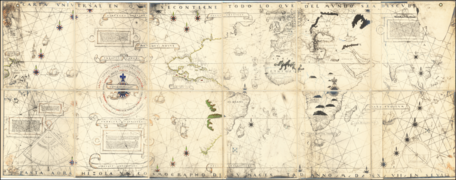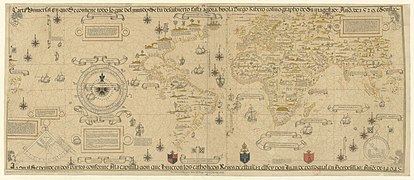Early world maps
The earliest known
With the Age of Discovery, during the 15th to 18th centuries, world maps became increasingly accurate; exploration of Antarctica, Australia, and the interior of Africa by western mapmakers was left to the 19th and early 20th century.
Antiquity
Bronze Age Saint-Bélec slab
The Saint-Bélec slab discovered in 1900 by Paul du Châtellier, in Finistère, France, is dated to between 1900 BCE and 1640 BCE. A recent analysis, published in the Bulletin of the French Prehistoric Society, has shown that the slab is a three-dimensional representation of the River Odet valley in Finistère, France. This would make the Saint-Bélec slab the oldest known map of a territory in the world. According to the authors, the map probably was not used for navigation, but rather to show the political power and territorial extent of a local ruler’s domain of the early Bronze age.[1][2][3][4]
Babylonian Imago Mundi (c. 6th c. BCE)

A Babylonian world map, known as the Imago Mundi, is commonly dated to the 6th century BCE.[5] The map as reconstructed by Eckhard Unger shows Babylon on the Euphrates, surrounded by a circular landmass including Assyria, Urartu (Armenia)[6] and several cities, in turn surrounded by a "bitter river" (Oceanus), with eight outlying regions (nagu) arranged around it in the shape of triangles, so as to form a star. The accompanying text mentions a distance of seven beru between the outlying regions. The descriptions of five of them have survived:[7]
- The third region is where "the winged bird ends not his flight", i.e., cannot reach.
- On the fourth region "the light is brighter than that of sunset or stars": it lay in the northwest, and after sunset in summer was practically in semi-obscurity.
- The fifth region, due north, lay in complete darkness, a land "where one sees nothing", and "the sun is not visible".
- The sixth region, "where a horned bull dwells and attacks the newcomer".
- The seventh region lay in the east and is "where the morning dawns".
Anaximander (c. 610–546 BCE)
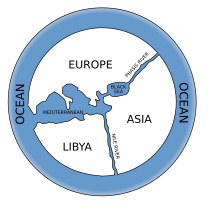
Anaximander (died c. 546 BCE) is credited with having created one of the first maps of the world,[8] which was circular in form and showed the known lands of the world grouped around the Aegean Sea at the center. This was all surrounded by the ocean.
Hecataeus of Miletus (c. 550–476 BCE)

Hecataeus of Miletus (died c. 476 BCE) is credited with a work entitled Periodos Ges ("Travels round the Earth" or "World Survey"), in two books each organized in the manner of a periplus, a point-to-point coastal survey. One, on Europe, is essentially a periplus of the Mediterranean, describing each region in turn, reaching as far north as Scythia. The other book, on Asia, is arranged similarly to the Periplus of the Erythraean Sea of which a version of the 1st century CE survives. Hecataeus described the countries and inhabitants of the known world, the account of Egypt being particularly comprehensive; the descriptive matter was accompanied by a map, based upon Anaximander's map of the Earth, which he corrected and enlarged. The work only survives in some 374 fragments, by far the majority being quoted in the geographical lexicon the Ethnica, compiled by Stephanus of Byzantium.
Eratosthenes (276–194 BCE)

Eratosthenes (276–194 BCE) drew an improved world map, incorporating information from the campaigns of Alexander the Great and his successors. Asia became wider, reflecting the new understanding of the actual size of the continent. Eratosthenes was also the first geographer to incorporate parallels and meridians within his cartographic depictions, attesting to his understanding of the spherical nature of the Earth.
Posidonius (c. 135–51 BCE)

Strabo (c. 64 BCE – 24 CE)
Strabo is mostly famous for his 17-volume work Geographica, which presented a descriptive history of people and places from different regions of the world known to his era.[14] The Geographica first appeared in Western Europe in Rome as a Latin translation issued around 1469. Although Strabo referenced the antique Greek astronomers Eratosthenes and Hipparchus and acknowledged their astronomical and mathematical efforts towards geography, he claimed that a descriptive approach was more practical. Geographica provides a valuable source of information on the ancient world, especially when this information is corroborated by other sources. Within the books of Geographica is a map of Europe. Whole world maps according to Strabo are reconstructions from his written text.
Pomponius Mela (c. 43 CE)
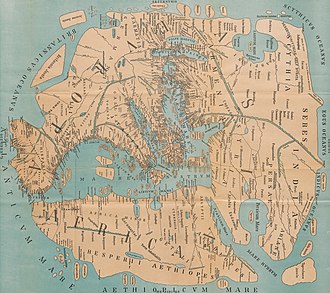
Pomponius is unique among ancient geographers in that, after dividing the Earth into five zones, of which two only were habitable, he asserts the existence of antichthones, people inhabiting the southern temperate zone inaccessible to the folk of the northern temperate regions due to the unbearable heat of the intervening torrid belt. On the divisions and boundaries of Europe, Asia and Africa, he repeats Eratosthenes; like all classical geographers from Alexander the Great (except Ptolemy) he regards the Caspian Sea as an inlet of the Northern Ocean, corresponding to the Persian (Persian Gulf) and Arabian (Red Sea) gulfs on the south.
Marinus of Tyre (c. 120 CE)
Marinus of Tyre's world maps were the first in the
Ptolemy (c. 150)

Surviving texts of
Tabula Peutingeriana (4th century)
The
Middle Ages
Cosmas Indicopleustes' Map (6th century)
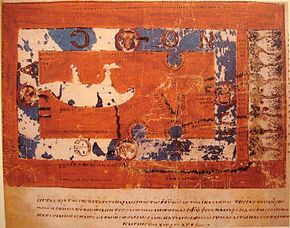
Around 550
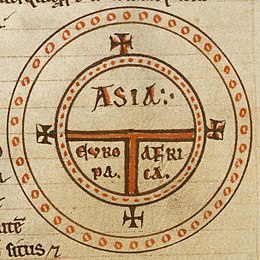
Isidore of Sevilla's T and O map (c. 636)
The medieval
Albi Mappa Mundi (8th century)
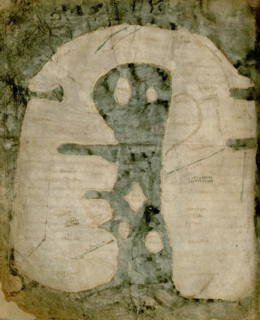
The Mappa mundi of Albi is a medieval map of the world, included in a manuscript of the second half of the 8th century, preserved in the old collection of the library Pierre-Amalric in Albi, France.[21] This manuscript comes from the chapter library of the Sainte-Cécile Albi Cathedral. The Albi Mappa Mundi was inscribed in October 2015 in the Memory of the World Programme of UNESCO.[22]
The manuscript bearing the card contains 77 pages. It is named in the eighteenth century "Miscellanea" (Latin word meaning "collection"). This collection contains 22 different documents, which had educational functions. The manuscript, a Parchment probably made from a goat or sheep skin, is in a very good state of preservation.
The map itself is 27 cm high by 22.5 wide. It represents 23 countries on 3 continents and mentions several cities, islands, rivers and seas.[23] The known world is represented in the form of a horseshoe, opening at the level of the Strait of Gibraltar, and surrounding the Mediterranean, with the Middle East at the top, Europe on the left and North Africa on the right.

Ibn Hawqal's map (10th century)
Ibn Hawqal was an Arab scientist of the 10th century who developed a world map, based on his own travel experience and probably the works of Ptolemy. Another such cartographer was Istakhri.[24]
Anglo-Saxon Cotton World Map (c. 1040)
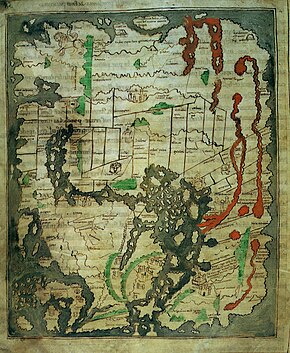
This map appears in a copy of a classical work on geography, the Latin version by
Like the later map by al-Idrisi (see below) this map is clearly outside the largely symbolic early medieval mapping tradition, but equally it is not based on the famous Ptolemaic co-ordinate system. East is at the top, but Jerusalem is not in the centre, and the Garden of Eden is nowhere to be seen. Unusually, all the waterways of Africa, not just the Red Sea, are depicted in red (mountains are green). The depiction of the far East is ambitious, including India and Taprobane (Sri Lanka) – the latter depicted according to the exaggerated classical conception of its size. Unsurprisingly, Britain itself is depicted in some detail. Great Britain, unusually by medieval standards, is shown as one island, albeit with an exaggerated Cornish promontory, and Mona, Ireland and the many Scottish islands are all indicated. The cartographer is slightly confused by Iceland, depicting it both by a version of its classical name 'Thule', north-west of Britain, and as 'Island', logically linked with Scandinavia.
An open-access high-resolution digital image of the map with place and name annotations is included among the thirteen medieval maps of the world edited in the Virtual Mappa project.
Beatus Mappa Mundi (1050)

Beatus of Liébana (c. 730–798) was an
Mahmud al-Kashgari's Map (1072)

Al-Idrisi's Tabula Rogeriana (1154)
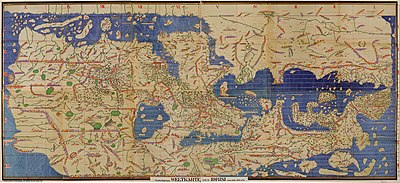
The Arab geographer,
Ebstorf Mappa Mundi (1235)
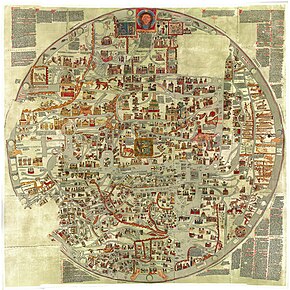
The Ebstorf Map was an example of a European mappa mundi, made by Gervase of Ebstorf, who was possibly the same man as Gervase of Tilbury,[28] some time in the thirteenth century. It was a very large map: painted on 30 goatskins sewn together, it measured about 3.6 m × 3.6 m (12 ft × 12 ft). The head of Christ was depicted at the top of the map, with his hands on either side and his feet at the bottom.[29] The Map was a greatly elaborated version of the medieval tripartite or T and O map; it was centred on Jerusalem with east at the top of the map. It represented Rome in the shape of a lion, and had an evident interest in the distribution of bishoprics.[30] The original was destroyed in the bombing of Hanover in 1943 during World War II, but some photographs and colour copies remain.
Hereford Mappa Mundi (1300)

The
Jerusalem is drawn at the centre of the circle, east is on top, showing the Garden of Eden in a circle at the edge of the world (1). Great Britain is drawn at the northwestern border (bottom left, 22 & 23). Curiously, the labels for Africa and Europe are reversed, with Europe scribed in red and gold as 'Africa', and vice versa.
An open-access high-resolution digital image of the map with more than 1,000 place and name annotations is included among the thirteen medieval maps of the world edited in the Virtual Mappa project.
Pietro Vesconte's World Map (1321)

Italian geographer Pietro Vesconte was a pioneer of the field of the portolan chart. His nautical charts are among the earliest to map the Mediterranean and Black Sea regions accurately. He also produced progressively more accurate depictions of the coastlines of northern Europe. In his world map of 1321 he brought his experience as a maker of portolans to bear; the map introduced a previously unheard of accuracy to the mappa mundi genre.[31] The world map, as well as a map of the Holy Land and plan of Acre and Jerusalem were made for inclusion in Marino Sanuto's Liber Secretorum Fidelium Crucis.[32]
Catalan World Atlas (1375)
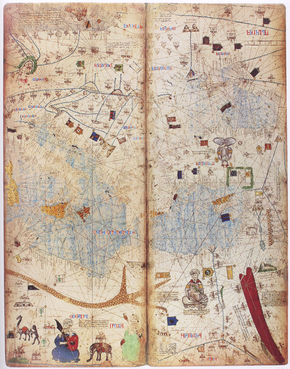
The Catalan World Atlas was produced by the
Unlike many other nautical charts, the Catalan Atlas is read with the north at the bottom. As a result of this the maps are oriented from left to right, from the Far East to the Atlantic. The first two leaves, forming the oriental portion of the Catalan Atlas, illustrate numerous religious references as well as a synthesis of medieval mappae mundi (Jerusalem located close to the centre) and the travel literature of the time, notably
"Da Ming Hunyi Tu" world map (after 1389)

The Da Ming Hunyi Tu (Chinese: 大明混一图; lit. 'Amalgamated Map of the Great Ming Empire') world map, likely made in the late 14th or the 15th century,[33] shows China at the centre and Europe, half-way round the globe, depicted very small and horizontally compressed at the edge. The coast of Africa is also mapped from an Indian Ocean perspective, showing the Cape of Good Hope area. It is believed that maps of this type were made since about the 1320s, but all earlier specimens have been lost, so the earliest survivor is the elaborate, colourful Da Ming Hunyi Tu, painted on 17 m2 (180 sq ft) of silk.
Gangnido world map (1402)
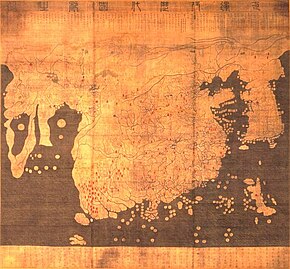
The Gangnido ("Map of Integrated Lands and Regions of Historical Countries and Capitals (of China)")[34] is a world map and historical map of China, made in Korea in 1402, although extant copies, all in Japan, were created much later. It plays a key role in reconstructing the content of the now-lost 14th-century Chinese map of the world named Shengjiao Guangbei Tu, which was based on Chinese cartographic techniques with additional input from western sources, via Islamic scholarship in the Mongol Empire. It also demonstrates the post-Mongol era stagnation of East Asian cartography as geographic information about the West was not updated until the introduction of European knowledge in the 16-17th centuries.[35] Superficially similar to the Da Ming Hun Yi Tu (which has been less well known in the West because it is kept in closed archive storage) the Gangnido shows its Korean origin in the enlargement of that country, and incorporates vastly improved (though wrongly positioned, scaled and oriented) mapping of Japan. Elsewhere, the map betrays a decorative rather than practical purpose, particularly in the portrayal of river systems, which form unnatural loops rarely seen on Chinese maps. Nonetheless, it is considered as "superior to anything produced in Europe prior to the end of the fifteenth century".[36]
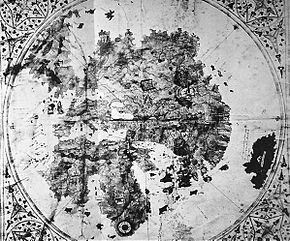
De Virga world map (1411–1415)
The De Virga world map was made by Albertinus de Virga between 1411 and 1415. Albertin de Virga, a Venetian, is also known for a 1409 map of the Mediterranean, also made in Venice. The world map is circular, drawn on a piece of parchment 69.6 cm × 44 cm (27.4 in × 17.3 in). It consists of the map itself, about 44 cm (17 in) in diameter, and an extension containing a calendar and two tables.
Bianco's world map (1436)

Andrea Bianco's atlas of 1436 comprises ten leaves of vellum, measuring 29 cm × 38 cm (11 in × 15 in), in an 18th-century binding. The first leaf contains a description of the Rule of marteloio for resolving the course, with the "circle and square", two tables and two other diagrams. The next eight leaves contain various navigation charts. The ninth leaf contains a circular world map measuring 25 cm (9.8 in) in circumference. And the final leaf contains the Ptolemaic world map on Ptolemy's first projection, with graduation. Some believe Bianco's maps were the first to correctly portray the coast of Florida, as a macro-peninsula is attached to a large island labeled Antillia. Bianco also collaborated with Fra Mauro on the Fra Mauro world map of 1459.

Borgia world map (early 15th century)
Mainly a decoration piece, the Borgia map is a world map made sometime in the early 15th century, and engraved on a metal plate.
Genoese map (1457)

The

Fra Mauro world map (1459)
The Fra Mauro map was made between 1457 and 1459 by the Venetian monk Fra Mauro. It is a circular planisphere drawn on parchment and set in a wooden frame, about 2 metres (6 ft 7 in) in diameter. The original world map was made by Fra Mauro and his assistant Andrea Bianco, a sailor-cartographer, under a commission by king Afonso V of Portugal. The map was completed on April 24, 1459, and sent to Portugal, but did not survive to the present day. Fra Mauro died the next year while he was making a copy of the map for the Seignory of Venice, and the copy was completed by Andrea Bianco.
The map is preserved in the
Martellus world map (1490)
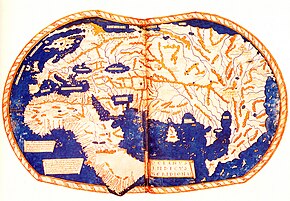
The world map of
Behaim's Erdapfel globe (1492)


The Erdapfel (
After 1492
Juan de la Cosa Map (1500)

The
Cantino Planisphere (1502)

The
Caverio Map (c. 1505)

The
Ruysch World Map (1507)

Waldseemüller and Ringmann map (1507)

The cartographers
Piri Reis Map (1513)

The Piri Reis map is a famous world map created by 16th-century Ottoman Turkish admiral and cartographer Piri Reis. The surviving third of the map shows part of the western coasts of Europe and North Africa with reasonable accuracy, and the coast of Brazil is also easily recognizable. Various Atlantic islands including the Azores and Canary Islands are depicted, as is the mythical island of Antillia. The map is noteworthy for its apparent south-eastward extension of the American continent to depict a southern landmass that some controversially claim is evidence for early awareness of the existence of Antarctica. Alternatively, it has been suggested that this is actually a record of the coast as far as Cape Horn, explored secretly by Portuguese navigators before 1507 (when it appeared on the Waldseemüller map) and bent south-eastward simply to fit on the parchment.
Pietro Coppo Map (1520)
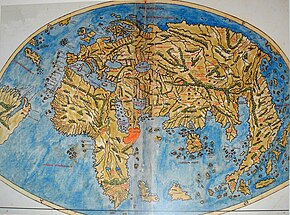
The map by Pietro Coppo was one of the last world maps to feature the "Dragon's Tail" extending southwards from the far eastern extremity of Asia, the last vestige of Ptolemy's landlocked depiction of the Indian Ocean, nearly 1,500 years earlier.
Padrón Real (1527)
The editions of the
The originals are now lost but six copies of known provenance have survived.
-
1525 Castiglione Map
-
1526 Salviati Planisphere
-
1527 Weimar Map
-
1529 Propaganda Map
Mercator world map (1569)

Theatrum Orbis Terrarum by Abraham Ortelius (1570)
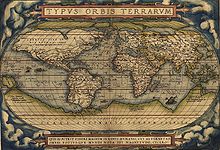
The Theatrum Orbis Terrarum (or "Theatre of the World") is considered to be the first true modern
Die ganze Welt in einem Kleberblat by Heinrich Bünting (1581)

The Bünting Clover Leaf Map, also known as The World in a Cloverleaf (
Today the map is found within the Eran Laor maps collection in the National Library of Israel in Jerusalem. A mosaic model of the map is installed on the fence of Safra Square at the site of Jerusalem's city hall.
The map is a figurative illustration, in the manner of the medieval mappa mundi format, depicting the world via a clover shape.[42] The shape is a symbolisation of the Christian Trinity and a component at the symbolisation of the German city Hanover, where Bünting was born. The city of Jerusalem is represented as the centre, surrounded by three central continents, with some more areas of the world being accordingly illustrated separately from the clover.
"Kunyu Wanguo Quantu" by Matteo Ricci (1602)

Kunyu Wanguo Quantu (
Hendrik Hondius map (1630)

Nova Totius Terrarum Orbis Geographica ac Hydrographica Tabula is a map of the world created by
Shahid-i Sadiq (1647)
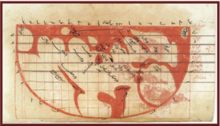
The Shahid-i Sadiq was an atlas composed by Sadiq Isfahani in
Nicolaes Visscher map (1658)

This engraved double hemisphere map, Orbis Terrarum Nova et Accuratissima Tabula, was created by
Gerard van Schagen's Map of the World (1689)
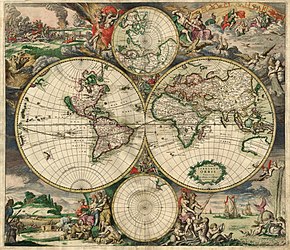
Gerard van Schagen (c. 1642–1724?) was a
Tovmas Vanandetsi world map (1695)

Hamatarats Ashkharhatsuyts (Geographic Map of the World),[53] was produced in 1695 in Amsterdam by the Armenian printing firm founded by Tovmas Vanandetsi. At the time, one of the most reliable maps of the two hemispheres was the first large-scale map drawn in Armenian.[54] The world map was created in a Western cartographic style. To engrave the map's copper plates, the Schoonebeek brothers, who were considered the best masters, were employed. The map is divided into eight sections, totaling 150 × 120 cm in size. The different portions of the map were adhered to a thin canvas to guard against damage during folding. The map has conventional, astrological, and mythical symbols representing the four seasons in each of its four corners.
Samuel Dunn's map of the world (1794)

See also
- Cylcon, Aboriginal Australian cylindro-conical stones some of which are thought to contain maps
- Dieppe maps, a series of 16th-century world maps produced in Dieppe, France
- "Here be dragons", a phrase indicating uncharted areas
- History of cartography
- Jambudvīpa, a geographic idea originated in India
- Johannes Schöner globe, made in 1520
- Mappa mundi, medieval European maps of the world
- Nebra sky disc, a Bronze Age "map" of the cosmos
- Terra incognita, uncharted territories documented in early maps
- Vinland Map, a claimed 15th-century map later confirmed as a 20th-century forgery
- Virtual Mappa, a project to digitise medieval mappa mundi
- Mao Kun map, also called Zheng He's navigation map, a world map dated to the 17th century but thought to be a copy of an early 15th-century map
Notes
- ^ Gershon, Livia. "Is This 4,000-Year-Old Bronze Age Slab the Oldest Known Map in Europe?". Smithsonian Magazine. Retrieved 9 April 2021.
- ^ "La plus ancienne carte d'Europe ?". Inrap (in French). 6 April 2021. Retrieved 9 April 2021.
- ^ "Bronze Age slab found in France is oldest 3D map in Europe". BBC News. 6 April 2021. Retrieved 14 April 2021.
- ^ Nicolas, C.; Pailler, Y.; Stephan, P.; Pierson, J.; Aubry, L.; Le Gall, B.; Lacombe, V.; Rolet, J. (April 2021). "La carte et le territoire : la dalle gravée du Bronze ancien de Saint-Bélec (Leuhan, Finistère)". Bulletin de la Société préhistorique française (in French). 118 (1): 99–146. Retrieved 14 April 2021.
- ^ British Museum Inv. No. 92687: "6th C BC approx".
See also: Siebold, Jim. Slide 103. Archived 2016-11-09 at the ISBN 978-1-4051-9146-3.
- JSTOR 1151277.
- ^ Finel, Irving (1995). A join to the map of the world: A notable discovery. pp. 26–27.
- ^ "Timechart of historical cartography: Antiquity". Archived from the original on 25 February 2021.
{{cite web}}: CS1 maint: unfit URL (link) - ^ "World map according to Eratosthenes (194 B.C.)". Archived from the original on 13 August 2021.
{{cite web}}: CS1 maint: unfit URL (link) - ^ "Poseidonius". Encyclopædia Britannica. "Greek philosopher, considered the most learned man of his time and, possibly, of the entire Stoic school."
- ^ Poseidonius, fragment 202
- ^ Brown, Lloyd Arnold (1979). The Story of Maps. Dover Publications. pp. 29–31.
- ISBN 978-1468308501.
- ^ Strabonis Geographica, Book 17, Chapter 7.
- ^ Vat. Urbinas Graecus 82.
- ^ Codex Seragliensis GI 57
- ^ ISBN 978-0226767475
- ^ Eastwood, B., and Graßhoff, G. (2004). "Planetary Diagrams for Roman Astronomy in Medieval Europe, ca. 800–1500". Transactions of the American Philosophical Society 94:3. pp. 49–50.
- ^ Macrobius, Commentary on the Dream of Scipio, transl. W. H. Stahl, (New York: Columbia University Press, 1952), chapters v-vii (pp. 200–212).
- ^ Michael Livingston, Modern Medieval Map Myths: The Flat World, Ancient Sea-Kings, and Dragons Archived 2006-02-09 at the Wayback Machine, 2002.
- ^ "Focus sur... La Mappa mundi d'Albi". mediatheques.grand-albigeois.fr (in French).
- ^ "La " Mappa mundi d'Albi " a rejoint en octobre 2015 le registre " Mémoire du monde " de l'Unesco". culture.fr (in French)..
- ^ "Présentation de la Mappa Mundi d'Albi". www.youtube.com (in French). Archived from the original on 21 December 2021.
- ^ The History of cartography by John Brian Harley, David Woodward pp. 120ff
- ^ Siebold, Jim Slide 210 monograph: Cottoniana or Anglo-Saxon Map Archived 2018-07-30 at the Wayback Machine, via henry-davis.com - accessed 2008-02-04
- ^ British Library Collect Britain Archived 2009-04-28 at the Wayback Machine, accessed 2008-03-14
- ^ 81 – The First Turkish World Map, by Kashgari (1072) « Strange Maps
- ^ Gervase of Tilbury, Otia Imperialia, (Oxford Medieval Texts), Oxford, 2002, p. xxxiv.
- ISBN 0-7123-4535-3.
- ^ Gervase of Tilbury, Otia Imperialia, (Oxford Medieval Texts), Oxford, 2002, p. xxxv
- ^ "Vesconte World Maps". Archived from the original on 17 February 2020.
{{cite web}}: CS1 maint: unfit URL (link) - ]
- ^ The place names on the map reflect the political situation in 1389, or the 22nd year of the reign of the Hongwu Emperor. Thus some Chinese scholars concluded that it was indeed created in 1389 or little later (Wang et al., Juanben caihui Daming Hunyi Tu yanjiu 绢本彩绘大明混一图研究 (As Regards the Da Ming Hun Yi Tu Drawn in Colours on Stiff Silk), in: Zhongguo gudai dituji: Ming dai 中國古代地图集 明代 (An Atlas of Ancient Maps in China: The Ming dynasty (1368–1644)), Beijing, 1994, pp. 51–55). Others maintain that this reflects an earlier source and that the Da Ming Hun Yi Tu itself was created much later (Miya Noriko, "Kon'itsu Kyōri Rekidai Kokuto no Zu" he no michi 「混一疆理歴代国都之図」への道, Mongoru jidai no shuppan bunka モンゴル時代の出版文化, 2006, 487–651 (pp. 511–512).
- ^ S2CID 128416415.
- ^ Miya Noriko 宮紀子 (2006). "Kon'itsu Kyōri Rekidai Kokuto no Zu" he no michi 「混一疆理歴代国都之図」への道". Mongoru jidai no shuppan bunka モンゴル時代の出版文化 (in Japanese). pp. 487–651.
- ISBN 0-582-36896-0.
- ^ ISBN 0-415-92026-4.
- ^ Behaim Globe at Bayern-online
- ^ Letter of Pero Vaz de Caminha, beijo as maãos de vosa alteza. deste porto seguro da vosa jlha da vera cruz (see original letter in archaic Portuguese, in the Portuguese Wikisource project): I kiss Your Majesty's Hands, from this safe haven of your island of Vera Cruz
- .
- ^ a b Ribero, Diego. "Carta Universal". Archived from the original on 9 November 2020.
{{cite web}}: CS1 maint: unfit URL (link) - ISBN 978-0-226-25545-3.
- ^ Rothstein, Edward (19 January 2010). "Map That Shrank the World". New York Times, Arts, Exhibition Review. New York: New York Times Company. Retrieved 20 January 2010.
- ^ "Nova totius terrarum orbis geographica ac hydrographica tabula". Norman B. Leventhal Map Center.
- ^ a b Isfahani, Sadiq (1647). "Map of the "Inhabited Quarter"" (PDF).
- ^ a b Schwartzberg, 1302
- ^ Schwartzberg, 1303
- ^ "Visscher, Nicolaes (1618–1679). Orbis Terrarum Nova et Accuratissima Tabula. Amsterdam: 1658". Christie's.
- Commonwealth Bank of Australia.
- ^ "van Schagen 1680 World & Continents". Archived from the original on 10 April 2016. Retrieved 9 October 2016.
- ^ Catalog of van Schagen's maps at the University of Amsterdam
- ^ Biographical sketch (in Dutch)
- ^ "RareMaps.com".
- ^ "Art-A-Tsolum". 21 August 2023.
- ^ Gordon Goodwin: "Dunn, Samuel (d.1794)" in Leslie Stephen, Dictionary of National Biography, 16, London, 1888, 211–213.
Further reading
- Brodersen, Kai (2012). "Chapter 4: Cartography". Geography in Classical Antiquity. By Dueck, Daniela. Cambridge: Cambridge Univ. Press. pp. 99–110. ISBN 9780521197885.
- Edson, Evelyn (1993). "The Oldest World Maps: Classical Sources of Three Eighth Century Mappaemundi". Ancient World. 24 (2): 169–184.
- Fox, Michael; Reimer, Stephen R (2008). Mappae Mundi: Representing the World and Its Inhabitants In Texts, Maps, and Images In Medieval and Early Modern Europe. Edmonton: Department of English and Film Studies, University of Alberta. OCLC 227019112.
- Goffart, Walter (2003). Historical Atlases: The First Three Hundred Years, 1570–1870. Chicago: Univ. of Chicago Press. OCLC 727367115.
- Harwood, Jeremy; Bendall, A. Sarah (2006). To the Ends of the Earth: 100 Maps That Changed the World. Cincinnati, OH: David & Charles. OCLC 75546416.
- Harvey, Paul D.A., ed. (2006). The Hereford World Map: Medieval World Maps and their Context. London: British Library. OCLC 0712347607.
- Shirley, Rodney W. (1993). The Mapping of the World: Early Printed World Maps 1472–1700. London: Holland Press. OCLC 29389647.
- Talbert, Richard J.A., ed. (2000). Barrington Atlas of the Greek and Roman World. Princeton, NJ: Princeton Univ. Press. OCLC 43970336.
- Wendt, Henry; Delaney, John; Bowles, Alex (2010). Envisioning the World: The First Printed Maps 1472–1700. Santa Rosa, CA: Sonoma County Museum. OCLC 617728973.
- Woodward, David (1985). "Reality, Symbolism, Time, and Space in Medieval World Maps". Annals of the Association of American Geographers. 75 (4): 510–521. .
External links
![]() Media related to Maps of the world before Columbus at Wikimedia Commons
Media related to Maps of the world before Columbus at Wikimedia Commons
- Index of Maps of the Early Medieval Period – HenryDavis.com Archived 2007-03-12 at the Wayback Machine
- Mapping History – resource from the British Library
- Geography and Map Reading Room at the Library of Congress
- Ancient World Maps
- The Peutinger Map
- Virtual Mappa: Digital Editions of Early Medieval Maps of the World, edit. Martin Foys, Heather Wacha, et al. (Philadelphia, PA: Schoenberg Institute of Manuscript Studies, 2018):
- Medieval Maps and Mapping Resources




